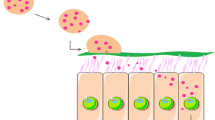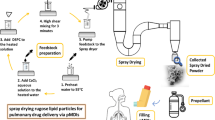Abstract
Background
With the recent approval of the first small interfering RNA (siRNA) therapeutic formulated as nanoparticles, there is increased incentive for establishing the factors of importance for the design of stable solid dosage forms of such complex nanomedicines.
Methods
The aims of this study were: (i) to identify factors of importance for the design of spray-dried siRNA-loaded lipidoid-poly(DL-lactic-co-glycolic acid) hybrid nanoparticles (LPNs), and (ii) to evaluate their influence on the resulting powders by using a quality-by-design approach. Critical formulation and process parameters were linked to critical quality attributes (CQAs) using design of experiments, and an optimal operating space (OOS) was identified.
Results
A series of CQAs were identified based on the quality target product profile. The loading (ratio of LPNs to the total solid content) and the feedstock concentration were determined as critical parameters, which were optimized systematically. Mannitol was chosen as stabilizing excipient due to the low water content of the resulting powders. The loading negatively affected the colloidal stability of the LPNs, whereas feedstock concentration correlated positively with the powder particle size. The optimal mannitol-based solid formulation, defined from the OOS, displayed a loading of 5% (w/w), mass median aerodynamic diameter of 3.3 ± 0.2 μm, yield of 60.6 ± 6.6%, and a size ratio of 1.15 ± 0.03. Dispersed micro-embedded LPNs had preserved physicochemical characteristics as well as in vitro siRNA release profile and gene silencing, as compared to non-spray-dried LPNs.
Conclusion
The optimal solid dosage forms represent robust formulations suitable for higher scale-up manufacturing.





Similar content being viewed by others
Abbreviations
- ACT:
-
β-actin
- CCF:
-
Central composite face
- CFP:
-
Critical formulation parameter
- COPD:
-
Chronic obstructive pulmonary disease
- CP:
-
Crossing point
- CPP:
-
Critical processing parameter
- CQAs:
-
Critical quality attributes
- DEPC:
-
Diethyl pyrocarbonate
- DoE:
-
Design of experiments
- FBS:
-
Fetal bovine serum
- GUS:
-
β-glucuronidase
- hATTR:
-
Hereditary transthyretin-mediated amyloidosis
- HD:
-
Heparin and detergent
- LPN:
-
Lipidoid-polymer hybrid nanoparticle
- LPS:
-
Lipopolysaccharide
- MLR:
-
Multiple linear regression
- MMAD:
-
Mass median aerodynamic diameter
- OFAT:
-
One-factor-at-a-time
- OG:
-
Octyl β-D-glucopyranoside
- OOS:
-
Optimal operating space
- PDI:
-
Polydispersity index
- PLGA:
-
Poly(DL-lactic-co-glycolic acid)
- PVA:
-
Polyvinylalcohol
- QbD:
-
Quality-by-design approach
- QTPP:
-
Quality target product profile
- SEM:
-
Scanning electron microscopy
- siRNA:
-
Small interfering RNA
- Tg :
-
Glass transition temperature
- TNF:
-
Tumor necrosis factor
- TTR:
-
Transthyretin
References
Hoy SM. Patisiran: first global approval. Drugs. 2018;78(15):1625–31.
Kulkarni JA, Cullis PR, van der Meel R. Lipid nanoparticles enabling gene therapies: from concepts to clinical utility. Nucleic Acid Ther. 2018;28(3):146–57.
Sosnik A, Seremeta KP. Advantages and challenges of the spray-drying technology for the production of pure drug particles and drug-loaded polymeric carriers. Adv Colloid Interf Sci. 2015;223:40–54.
Vehring R. Pharmaceutical particle engineering via spray drying. Pharm Res. 2008;25(5):999–1022.
Kumar S, Gokhale R, Burgess DJ. Sugars as bulking agents to prevent nano-crystal aggregation during spray or freeze-drying. Int J Pharm. 2014;471(1–2):303–11.
Bohr A, Water J, Beck-Broichsitter M, Yang M. Nanoembedded microparticles for stabilization and delivery of drug-loaded nanoparticles. Curr Pharm Des. 2015;21(40):5829–44.
Kumar S, Gokhale R, Burgess DJ. Quality by design approach to spray drying processing of crystalline nanosuspensions. Int J Pharm. 2014;464(1–2):234–42.
Crowe JH, Hoekstra FA, Crowe LM. Anhydrobiosis. Annu Rev Physiol. 1992;54:579–99.
Crowe JH, Carpenter JF, Crowe LM. The role of vitrification in anhydrobiosis. Annu Rev Physiol. 1998;60:73–103.
Koynova R, Brankov J, Tenchov B. Modulation of lipid phase behavior by kosmotropic and chaotropic solutes : Experiment and thermodynamic theory. Eur Biophys J. 1997;25(4):261–74.
Branca C, Maccarrone S, Magazu S, Maisano G, Bennington SM, Taylor J. Tetrahedral order in homologous disaccharide-water mixtures. J Chem Phys. 2005;122(17):174513.
Akinc A, Zumbuehl A, Goldberg M, Leshchiner ES, Busini V, Hossain N, et al. A combinatorial library of lipid-like materials for delivery of RNAi therapeutics. Nat Biotechnol. 2008;26(5):561–9.
Thanki K, Zeng X, Justesen S, Tejlmann S, Falkenberg E, Van Driessche E, et al. Engineering of small interfering RNA-loaded lipidoid-poly(DL-lactic-co-glycolic acid) hybrid nanoparticles for highly efficient and safe gene silencing: a quality by design-based approach. Eur J Pharm Biopharm. 2017;120:22–33.
Jansen MAA, Klausen LH, Thanki K, Lyngso J, Skov Pedersen J, Franzyk H, et al. Lipidoid-polymer hybrid nanoparticles loaded with TNF siRNA suppress inflammation after intra-articular administration in a murine experimental arthritis model. Eur J Pharm Biopharm. 2019;142:38–48.
Wouters EF. Local and systemic inflammation in chronic obstructive pulmonary disease. Proc Am Thorac Soc. 2005;2(1):26–33.
Cazzola M, Page CP, Calzetta L, Matera MG. Emerging anti-inflammatory strategies for COPD. Eur Respir J. 2012;40(3):724–41.
Cazzola M, Rogliani P, Ora J, Matera MG. Treatment options for moderate-to-very severe chronic obstructive pulmonary disease. Expert Opin Pharmacother. 2016;17(7):977–88.
Jensen DK, Jensen LB, Koocheki S, Bengtson L, Cun D, Nielsen HM, et al. Design of an inhalable dry powder formulation of DOTAP-modified PLGA nanoparticles loaded with siRNA. J Control Release. 2012;157(1):141–8.
Jensen LB, Griger J, Naeye B, Varkouhi AK, Raemdonck K, Schiffelers R, et al. Comparison of polymeric siRNA nanocarriers in a murine LPS-activated macrophage cell line: gene silencing, toxicity and off-target gene expression. Pharm Res. 2012;29(3):669–82.
Thanki K, Papai S, Lokras A, Rose F, Falkenberg E, Franzyk H, et al. Application of a quality-by-design approach to optimise lipid-polymer hybrid nanoparticles loaded with a splice-correction antisense oligonucleotide: Maximising loading and intracellular delivery. Pharm Res. 2019;36(3):37.
Groneberg DA, Witt C, Wagner U, Chung KF, Fischer A. Fundamentals of pulmonary drug delivery. Respir Med. 2003;97(4):382–7.
Baldinger A, Clerdent L, Rantanen J, Yang M, Grohganz H. Quality by design approach in the optimization of the spray-drying process. Pharm Dev Technol. 2012;17(4):389–97.
Ingvarsson PT, Yang M, Mulvad H, Nielsen HM, Rantanen J, Foged C. Engineering of an inhalable DDA/TDB liposomal adjuvant: a quality-by-design approach towards optimization of the spray drying process. Pharm Res. 2013;30(11):2772–84.
Ritger PL, Peppas NA. A simple equation for description of solute release I. Fickian and non-fickian release from non-swellable devices in the form of slabs, spheres, cylinders or discs. J Control Release. 1987;5(1):23–36.
Kim H, Fassihi R. Application of binary polymer system in drug release rate modulation. 2. Influence of formulation variables and hydrodynamic conditions on release kinetics. J Pharm Sci. 1997;86(3):323–8.
Maas SG, Schaldach G, Littringer EM, Mescher A, Griesser UJ, Braund DE, et al. The impact of spray drying outlet temperature on the particle morphology of mannitol. Powder Technol. 2011;213(1–3):27–35.
Jensen DM, Cun D, Maltesen MJ, Frokjaer S, Nielsen HM, Foged C. Spray drying of siRNA-containing PLGA nanoparticles intended for inhalation. J Control Release. 2010;142(1):138–45.
Xu E-Y, Guo J, Xu Y, Li H-Y, Seville PC. Influence of excipients on spray-dried powders for inhalation. Powder Technol. 2014;256:217–23.
Xia D, Shrestha N, van de Streek J, Mu H, Yang M. Spray drying of fenofibrate loaded nanostructured lipid carriers. Asian J Pharm Sci. 2016;11(4):507–15.
Leung SSY, Parumasivam T, Nguyen A, Gengenbach T, Carter EA, Carrigy NB, et al. Effect of storage temperature on the stability of spray dried bacteriophage powders. Eur J Pharm Biopharm. 2018;127:213–22.
Maa YF, Nguyen PA, Andya JD, Dasovich N, Sweeney TD, Shire SJ, et al. Effect of spray drying and subsequent processing conditions on residual moisture content and physical/biochemical stability of protein inhalation powders. Pharm Res. 1998;15(5):768–75.
Crouter A, Briens L. The effect of moisture on the flowability of pharmaceutical excipients. AAPS PharmSciTech. 2014;15(1):65–74.
Chew NY, Chan HK. The role of particle properties in pharmaceutical powder inhalation formulations. J Aerosol Med. 2002;15(3):325–30.
Grasmeijer N, de Waard H, Hinrichs WL, Frijlink HW. A user-friendly model for spray drying to aid pharmaceutical product development. PLoS One. 2013;8(9):e74403.
Allison SD, Molina MC, Anchordoquy TJ. Stabilization of lipid/DNA complexes during the freezing step of the lyophilization process: the particle isolation hypothesis. Biochim Biophys Acta. 2000;1468(1–2):127–38.
Costantino HR, Andya JD, Nguyen PA, Dasovich N, Sweeney TD, Shire SJ, et al. Effect of mannitol crystallization on the stability and aerosol performance of a spray-dried pharmaceutical protein, recombinant humanized anti-IgE monoclonal antibody. J Pharm Sci. 1998;87(11):1406–11.
Telang C, Yu L, Suryanarayanan R. Effective inhibition of mannitol crystallization in frozen solutions by sodium chloride. Pharm Res. 2003;20(4):660–7.
Yoshinari T, Forbes RT, York P, Kawashima Y. Crystallisation of amorphous mannitol is retarded using boric acid. Int J Pharm. 2003;258(1–2):109–20.
Bosquillon C, Lombry C, Preat V, Vanbever R. Influence of formulation excipients and physical characteristics of inhalation dry powders on their aerosolization performance. J Control Release. 2001;70(3):329–39.
Amaro MI, Tajber L, Corrigan OI, Healy AM. Optimisation of spray drying process conditions for sugar nanoporous microparticles (NPMPs) intended for inhalation. Int J Pharm. 2011;421(1):99–109.
Maltesen MJ, Bjerregaard S, Hovgaard L, Havelund S, van de Weert M. Quality by design - spray drying of insulin intended for inhalation. Eur J Pharm Biopharm. 2008;70(3):828–38.
Elversson J, Millqvist-Fureby A, Alderborn G, Elofsson U. Droplet and particle size relationship and shell thickness of inhalable lactose particles during spray drying. J Pharm Sci. 2003;92(4):900–10.
Mosen K, Backstrom K, Thalberg K, Schaefer T, Kristensen HG, Axelsson A. Particle formation and capture during spray drying of inhalable particles. Pharm Dev Technol. 2004;9(4):409–17.
Tsuda A, Henry FS, Butler JP. Particle transport and deposition: basic physics of particle kinetics. Compr Physiol. 2013;3(4):1437–71.
Fernandez Tena A, Casan Clara P. Deposition of inhaled particles in the lungs. Arch Bronconeumol. 2012;48(7):240–6.
Agnoletti M, Bohr A, Thanki K, Wan F, Zeng X, Boetker JP, et al. Inhalable siRNA-loaded nano-embedded microparticles engineered using microfluidics and spray drying. Eur J Pharm Biopharm. 2017;120:9–21.
Feldmann DP, Merkel OM. The advantages of pulmonary delivery of therapeutic siRNA. Ther Deliv. 2015;6(4):407–9.
Waghmare SP, Pousinis P, Hornby DP, Dickman MJ. Studying the mechanism of RNA separations using RNA chromatography and its application in the analysis of ribosomal RNA and RNA:RNA interactions. J Chromatogr A. 2009;1216(9):1377–82.
Audouy SA, van der Schaaf G, Hinrichs WL, Frijlink HW, Wilschut J, Huckriede A. Development of a dried influenza whole inactivated virus vaccine for pulmonary immunization. Vaccine. 2011;29(26):4345–52.
Acknowledgments and Disclosures
We gratefully acknowledge financial support from the Novo Nordisk Foundation - Denmark (Grant No. NNF17OC0026526), Hørslev-Fonden – Denmark, the Lundbeck Foundation – Denmark (Grant No. R219–2016-908) and Independent Research Fund Denmark (Grant No. DFF-4184-00422). We are also grateful to the Innovative Medicines Initiative Joint Undertaking under grant agreement No.115363 resources which are composed of financial contribution from the European Union’s Seventh Framework Programme (FP7/2007–2013) and EFPIA companies’ in kind contribution. This project has received funding from the European Union’s Seventh Framework Programme for research, technological development and demonstration under grant agreement No. 600207. We acknowledge the Danish Agency for Science, Technology and Innovation for funding the Zetasizer Nano ZS. We also acknowledge the Alfred Benzon Foundation and Drug Research Academy for co-funding the FLUOstar OPTIMA plate reader and Drug Research Academy for funding the Small-Scale Powder Disperser. Novo Nordisk has kindly supplied the Aerodynamic Particle Sizer Spectrometer 3321. The funding sources had no involvement in the study design; in the collection, analysis, and interpretation of data; in the writing of the report; nor in the decision to submit the paper for publication. We are grateful to Emily Falkenberg for synthesizing and purifying L5 and to Xianghui Zeng for technical assistance. The authors report no potential conflicts.
Author information
Authors and Affiliations
Corresponding author
Additional information
Guest Editor: Joshua Reineke
Publisher’s Note
Springer Nature remains neutral with regard to jurisdictional claims in published maps and institutional affiliations.
Electronic supplementary material
ESM 1
(DOCX 83 kb)
Rights and permissions
About this article
Cite this article
Dormenval, C., Lokras, A., Cano-Garcia, G. et al. Identification of Factors of Importance for Spray Drying of Small Interfering RNA-Loaded Lipidoid-Polymer Hybrid Nanoparticles for Inhalation. Pharm Res 36, 142 (2019). https://doi.org/10.1007/s11095-019-2663-y
Received:
Accepted:
Published:
DOI: https://doi.org/10.1007/s11095-019-2663-y




